I know that the constant current led driver is not used in the parallel led strip. and constant voltage led driver is not used in the series led strip.
can anyone explain me with the example that why this scenario is followed?
Thank you
I know that the constant current led driver is not used in the parallel led strip. and constant voltage led driver is not used in the series led strip.
can anyone explain me with the example that why this scenario is followed?
Thank you
I know that the constant current led driver is not used in the parallel led strip.
Assume three different LEDs from the same batch and manufacturer. Let's say it's from this Dialight Datasheet. The datasheet says that at \$10\:\text{mA}\$ the LED voltages may vary from \$2.8\:\text{V}\$ to \$3.4\:\text{V}\$. This datasheet doesn't provide sufficient information, only specifying a maximum pulsed current of \$100\:\text{mA}\$. But in general LEDs will also tend to have 10 times the current if you increase the voltage across them by from \$100\:\text{mV}\$ to perhaps \$150\:\text{mV}\$. Let's say you grab up three LEDs from this manufacturer which, at a constant current of \$10\:\text{mA}\$ exhibit: (A) \$2.96\:\text{V}\$, (B) \$3.17\:\text{V}\$, and (C) \$3.3\:\text{V}\$. (For LEDs I'll call A, B, and C.) Let's also assume (we can't know for sure) that the 10X change in current for each LED requires \$125\:\text{mV}\$. (Same figure for all three to keep things simpler.)
Let's set the constant current driver to \$20\:\text{mA}\$ and see what happens. (I've used some random models for each of the three LEDs consistent with the datasheet and the specs I added above.) I then calculate that the constant current driver will wind up providing about \$3.02\:\text{V}\$ (which appears equally across all three LEDs.) This yields the following individual LED currents: (A) \$16.2\:\text{mA}\$, (B) \$2.7\:\text{mA}\$, and (C) \$1.1\:\text{mA}\$.
As you can see, the currents aren't anywhere near close to evenly distributed between the three LEDs.
That's the problem with putting them in parallel with a constant current source. The currents aren't evenly distributed. Not even close. Even with LEDs from the same manufacturer and even the same batch.
and constant voltage led driver is not used in the series led strip.
Since they are in series, they will all experience exactly the same current. So if you allocate part of the constant voltage source for current regulation and assign a resistor to that function, then this works.
However, if you don't use a series resistor to drop some percentage of the total voltage allocated, then this doesn't work well. The reason is about the same as before. The voltages vary widely between different LEDs at the same current, even if they are from the same batch and manufacturer. And since the current can vary quite a lot with only a small variation in applied voltage, it only takes a small difference between the fixed voltage source's voltage and the required sum of LED voltages to yield a very wide difference in LED currents.
Suppose you provided a \$10\:\text{V}\$ source for the three LEDs I already mentioned above. Then you'd see about \$46\:\text{mA}\$ through all of them. Again, this is nothing like you'd normally expect to see.
Putting a resistor in series is critical, in this case. (Or using a more sophisticated circuit.)
LED brightness is proportional to the current flowing in it. If you use a constant current source with parallel LEDs then the current will divide, hence the LED brightness decreases. To understand it better here is the diode piecewise linear model or diode equivalent model in forward bias condition.
As you can see diode in forward bias has a voltage source (which is cut in voltage \$v_r\$), resistor. The current will divide according to KCL, so in series the voltage drops \$v_r\$ will add up. If you connect more LEDs in series the LED may not be forward biased hence KVL plays a prominent role here.